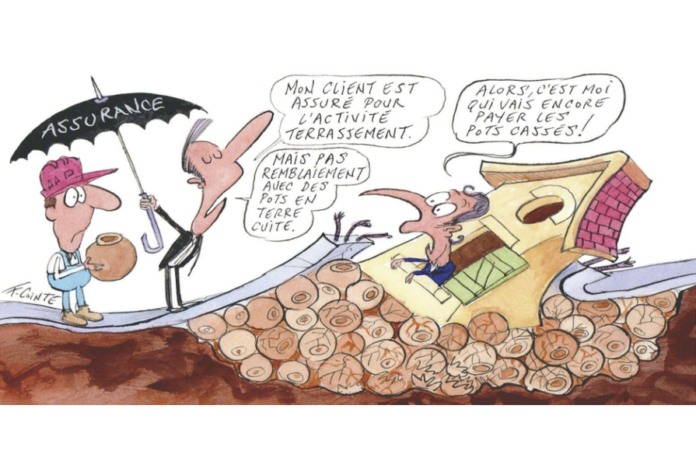Prior to questions regarding mobilization or not of the guarantee in case of damage, it is necessary that the risk has been identified as clearly and precisely as possible. The underwriting phase of the covered risk therefore plays a decisive role. In this phase, the insurance company will especially want to identify precisely the future insured’s activity in order to assess the related risks, but also his compensation needs in the event that these risks arise. To do this, he will ask for a certain amount of information that will allow him to determine the purpose of the guarantee. Through this process, the insurance company will be able to regulate and limit its guarantee in relation to the statements made by the insured.
Insurance companies have established a practice of drafting clauses relating to covered activities in an increasingly detailed and complex manner, sometimes running to almost a page, introducing all sorts of clarifications, some of which are technical in nature.
The option to limit the guarantee through the activity sector indicated by the insured
This is in accordance with the terms of two principle judgments delivered on 29 April (
Uninsurance. With these two judgments, the Court laid down the principle that a manufacturer who takes out a ten-year liability insurance (RCD) for a specific sector of activity cannot benefit from the guarantee, since he carries out activities outside this latter.
The High Court does not hesitate to repeat its position regularly. The principle is now clear. Carrying out work relating to an activity other than that declared to the insurance company would not in fact constitute a reason for exclusion not permitted under the mandatory 10-year insurance, but a case of lack of insurance.
A strict assessment of the declared activity
Jurisprudence strictly assesses the activity declared by the insured, considering that since the activity carried out on the construction site is not strictly identical to the one mentioned in the policy, the insurance company can deny coverage. The proof is again with a judgment handed down at the beginning of the year (
The insured can rely on the insurance company’s failure to fulfill a prior disclosure obligation.
The Court of Cassation overturned the judgment on the grounds that the insurance company guaranteed to a limited extent the following activities: “Demolition, earthworks, road work, construction and routine masonry work, reinforced concrete, engineering structures and industrial equipment in reinforced concrete, timber frame, roofing, zinc work”, and not the disputed stone filling works . And this regardless of the details of the nomenclature.
Serious consequences. However, the consequences are significant, as a certain number of policyholders are left without insurance and sometimes unable to finance repairs as a result. Even more, denial of insurance enforceable against third-party victims, under
Liability of the insurance company as collateral
Faced with the spread of warranty denials by insurance companies, the objective sought by the Court of Cassation was to limit this displacement, especially from the point of view of the relationship between the injured party and the insurer between third parties. To do this, it took refuge in the area of possible inaccuracies and ambiguities in the wording of the covered activity appearing in the insurance certificates, which could be raised by third-party victims, given that this would likely involve the civil liability of the insurer.
Contractual Liability… The Court of Cassation firstly admitted that the RCD insurance company could incur contractual liability towards the insured as long as the latter proves fault, damage and a causal relationship based on
The desire to protect the consumer, who is presumed to be weak against professionals such as insurance companies, has led jurisprudence, as well as the legislature, to strengthen the duty of information and advice that burdens them. Legal rules that follow
…or tort. The insurer’s liability for damages can also arise when a third-party beneficiary considers that he suffers damage that can be attributed to him due to the fault of the insurance company. In light of the strict jurisprudence of the Court of Cassation, which admits the enforcement of non-insurance against third-party injured parties as soon as a manufacturer intervenes outside the sector of activity declared by its RCD insurer, it seemed obvious that the High Court had to exercise the same rigor in cases where insurance companies distribute ambiguous documents about the summary of the guarantees they have issued. Third-party beneficiaries must be able to know exactly which activity their co-contractor is guaranteed for. Based on this principle, the Court therefore systematically upholds the RCD insurance company’s commercial civil liability towards the injured party as soon as the insurance certificate leaves doubt as to the scope of the covered activities.
What you need to remember
The interpretation of the sector of business activity as declared by the insured is undoubtedly a source of ample disagreement. The wording of their wording gives insurers several opportunities to assert non-warranties, both against policyholders and third-party victims, despite the efforts of the Court of Cassation to limit the effects of its 1997 jurisprudence.
Policyholders must therefore exercise great vigilance in the pre-contractual phase and especially during the underwriting of the risk.
The insured is also advised, where appropriate, not to hesitate to make spontaneous declarations under the contract if he realizes that one of his activities will not be covered or if he intends to carry out a new activity.
